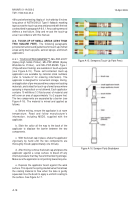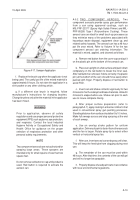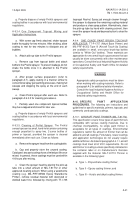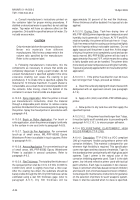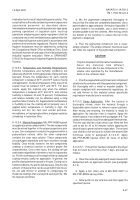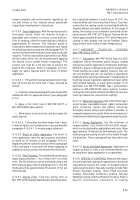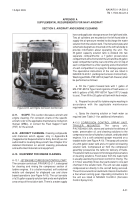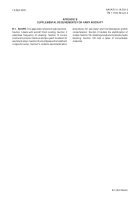TM-1-1500-344-23-2 - Page 196 of 240
A-26
NAVAIR 01-1A-509-2
TM 1-1500-344-23-2
15 April 2009
A-10.4.7.1. If the primer has dried for over 24 hours but
not longer than 7 days, proceed as follows:
a. Clean the surface by wiping with clean cheesecloth
dampened with an approved solvent (see paragraph
A-7.4).
b. Apply a thin (mist) coat of TT-P-2760 primer.
c. Allow primer to dry tack-free and then apply the
specified topcoat.
A-10.4.7.2. If the primer has dried longer than 7 days,
it must be lightly scuff sanded prior to proceeding with
paragraph A-10.4.7.1, to ensure proper adhesion.
A-10.5. POLYURETHANE AIRCRAFT COATING
(MIL-PRF-85285).
A-10.5.1. Description.
A-10.5.1.1. MIL-PRF-85285 Type I, Polyurethane
Coating is a VOC compliant (420 g/l maximum) topcoat.
This specification covers three types of materials. Type I
is intended for aircraft use. Type II is intended for use on
ground support equipment (GSE) and is not for use on
aircraft surfaces. Type III is a low VOC (50 g/l) coating
intended for use on both aircraft and GSE. Type III shall
not be substituted for Type I or Type II without
authorization from the aircraft engineering authority.
Type I material is available in gloss, semigloss, and flat
(lusterless) colors. It is intended for use over properly
applied primers conforming to MIL-PRF-23377,
MIL-PRF-85582, or TT-P-2760. The resulting paint
system is durable, flexible, weather resistant, corrosion
resistant, and chemical resistant.
A-10.5.1.2. Self-Priming Topcoat, TT-P-2756, is no
longer approved for use on Navy aircraft or equipment.
A-10.5.2. Safety Requirements for Polyurethane
Coatings Containing Free Isocyanates. Some
polyurethane coatings used on Navy and Marine Corps
aircraft, such as MIL-PRF-85285, require special
handling during mixing, application, and curing to avoid
exposure to free isocyanate vapors. Adequate ventilation
and approved respiratory protection are mandatory.
Polyurethane coatings generally present no special
health hazards when cured (dried), however,
isocyanates are an integral part of the polyurethane
reaction and can be released while the coating is still
wet. Isocyanate vapors, even in very small
concentrations, can produce significant irritation of the
skin, eyes, and respiratory tract and may also induce
allergic sensitization of personnel. Specific details are
provided in OPNAVINST 5100.23.
A-10.5.2.1. Sensitization. Isocyanate sensitization is
characterized by bronchial constriction, causing difficulty
in breathing, dry cough, and shortness of breath.
Individual susceptibility appears to be a controlling
factor. Once sensitized, many personnel cannot tolerate
even minimal subsequent exposure to isocyanates,
and must thereafter avoid work areas where such
exposure could occur. In addition, solvents employed
with polyurethane coatings tend to increase the rate of
absorption and severity of the physiological effect.
A-10.5.2.2. Medical Examinations. All personnel
assigned duties involving the mixing and application of
polyurethane coatings that contain free isocyanates
shall receive a baseline medical examination following
the guidance of the current edition of the
NAVENVIRHLTHCEN Medical Surveillance Procedures
Manual to include the protocols for mixed solvents and
isocyanates. Periodic medical examinations are required
if the results of the industrial hygiene survey recommend
them.
A-10.5.2.3. Protective Clothing. Protective clothing
listed shall not be substituted without specific approval
by the local industrial hygienist.
Personnel applying
polyurethane coating that contains free isocyanates
shall wear gloves (MIL-G-12223 or meeting OSHA
requirements), chemical or splash-proof goggles,
coveralls (A-A-55196 or MIL-C-2202) and respiratory
protection as specified by the local Industrial Hygiene
activity. When this polyurethane coating is applied in
confined spaces (i.e., intake ducts), contact the local
Industrial Hygiene activity for guidance on proper
respiratory protection. Consult OPNAVINST 5100.23
for further information.
NOTE
Personnel wearing respirators are required to
receive initial and annual fit testing.
A-10.5.2.4. Unprotected Personnel. The hangar area
shall be cordoned off during paint application to prevent
exposure to unprotected personnel. Safe distances for
unprotected personnel, as determined by the local
Industrial Hygiene activity, must be maintained at all
times.
A-10.5.2.5. Facility Requirements. Polyurethane
painting operations employing free isocyanates shall
be conducted in an area which has received a workplace
Back to Top



